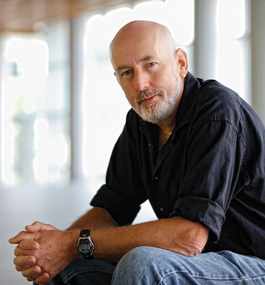Scientists Shine New Light on Black Holes
Event Horizon Telescope image hailed as an astrophysical game changer.

Mike Lovett
John Wardle
by Lawrence Goodman
For a few days in April, the photo of a hazy black hole encircled by a glowing ring of fire seemed to be everywhere. For the international consortium of scientists who compiled the image, it represented a major scientific breakthrough — the first-ever photo of a black hole, a ubiquitous yet mysterious inhabitant of the cosmos.
A black hole is typically created when a very massive star burns through its nuclear fuel and collapses cataclysmically into an incredibly dense point, or singularity. When gas, stars or other matter get close to the black hole, they are drawn toward the black hole’s event horizon, an imaginary shell around the singularity. Nothing that passes across the threshold of the event horizon can escape the black hole’s gravitational pull, not even light. As matter falls in, the black hole gets more massive, and the event horizon expands.
Astrophysics professor John Wardle, a radio astronomy expert, was part of the team that worked on the black-hole image project, which involved networking together an array of radio telescopes, collectively called the Event Horizon Telescope, at six locations across the globe to create a “virtual telescope” with unprecedented sensitivity and resolution. At the center of most galaxies lies a supermassive black hole with a mass of a billion or more suns. Its event horizon is as large as our solar system, and, if the galaxy is near enough, the Event Horizon Telescope can just see it.
The black hole shown in the photo lies at the center of the Messier 87 (M87), a giant elliptical galaxy located 55 million light-years from Earth in the center of the Virgo cluster of galaxies.
In this Q&A, Wardle explains why the black-hole photo was such an important breakthrough.
The black hole actually turns out to look like scientists predicted. Is this a bit disappointing?
I don’t know if I am happy or sad. It is always exciting to discover a completely new and unexpected effect that keeps the theoreticians up at night, but it is also very satisfying when what you expected turns out to be precisely true. That makes you feel that you really do understand some small part of our universe.
The image of the M87 black hole is said to confirm predictions made by Albert Einstein’s theory of general relativity. Hadn’t this theory already been proven?
Until recently, GR had been tested only within our solar system, where the differences between Einstein’s gravity and Isaac Newton’s gravity are small and hard to measure. This observation is a test of “strong gravity,” where the differences are large and observable.
The first test of strong gravity was the Laser Interferometer Gravitational-Wave Observatory’s observation of gravitational radiation from two colliding and merging black holes. That tested the dynamical behavior of GR. The Event Horizon Telescope tests the underlying static gravitational field predicted by GR for an isolated black hole. GR passes both tests with flying colors.
So Einstein really was the genius everyone thinks he was.
What is extraordinary is that GR, first published 100 years ago, appears to be an exactly correct description of the physical world we live in, whatever tests we subject it to. I can’t think of another physical theory that has lasted so long and so successfully.
